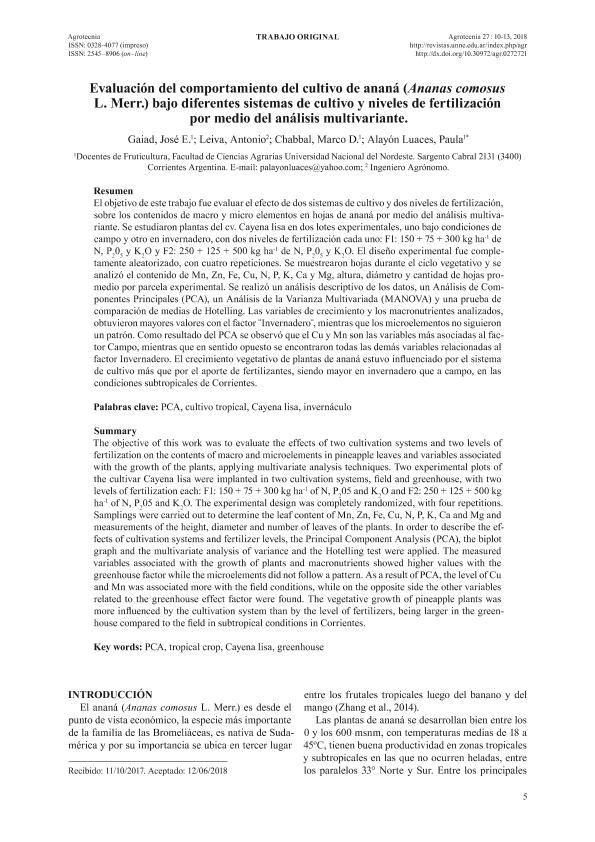Artículo
El objetivo de este trabajo fue evaluar el efecto de dos sistemas de cultivo y dos niveles de fertilización, sobre los contenidos de macro y micro elementos en hojas de ananá por medio del análisis multivariante. Se estudiaron plantas del cv. Cayena lisa en dos lotes experimentales, uno bajo condiciones de campo y otro en invernadero, con dos niveles de fertilización cada uno: F1: 150 + 75 + 300 Kg ha-1 de N, P205 y K2O y F2: 250 + 125 + 500 Kg ha-1 de N, P205 y K2O. El diseño experimental fue completamente aleatorizado, con cuatro repeticiones. Se muestrearon hojas durante el ciclo vegetativo y se analizó el contenido de Mn, Zn, Fe, Cu, N, P, K, Ca y Mg, altura, diámetro y cantidad de hojas promedio por parcela experimental. Se realizó un análisis descriptivo de los datos, un Análisis de Componentes Principales (PCA), un Análisis de la Varianza Multivariada (MANOVA) y una prueba de comparación de medias de Hotelling. Las variables de crecimiento y los macronutrientes analizados, obtuvieron mayores valores con el factor ¨Invernadero¨, mientras que los microelementos no siguieron un patrón. Resultado del PCA se observó que el Cu y Mn son las variables más asociadas al factor Campo, mientras que en sentido opuesto se encontraron todas las demás variables relacionadas al factor Invernadero. El crecimiento vegetativo de plantas de ananá, estuvo influenciado por el sistema de cultivo más que por el aporte de fertilizantes, siendo mayor en invernadero que a campo, en las condiciones subtropicales de Corrientes The objective of this work was to evaluate the effects of two cultivation systems and two levels of fertilization on the contents of macro and microelements in pineapple leaves and variables associated with the growth of the plants, applying multivariate analysis techniques. Two experimental plots of the cultivar Cayena lisa were implanted in two cultivation systems, field and greenhouse, with two levels of fertilization each: F1: 150 + 75 + 300 kg ha-1 of N, P2 05 and K2 O and F2: 250 + 125 + 500 kg ha-1 of N, P2 05 and K2 O. The experimental design was completely randomized, with four repetitions. Samplings were carried out to determine the leaf content of Mn, Zn, Fe, Cu, N, P, K, Ca and Mg and measurements of the height, diameter and number of leaves of the plants. In order to describe the effects of cultivation systems and fertilizer levels, the Principal Component Analysis (PCA), the biplot graph and the multivariate analysis of variance and the Hotelling test were applied. The measured variables associated with the growth of plants and macronutrients showed higher values with the greenhouse factor while the microelements did not follow a pattern. As a result of PCA, the level of Cu and Mn was associated more with the field conditions, while on the opposite side the other variables related to the greenhouse effect factor were found. The vegetative growth of pineapple plants was more influenced by the cultivation system than by the level of fertilizers, being larger in the greenhouse compared to the field in subtropical conditions in Corrientes.
Evaluación del comportamiento del cultivo de ananá (Ananas comosus L. Merr.) bajo diferentes sistemas de cultivo y niveles de fertilización por medio del análisis multivariante
Fecha de publicación:
10/2018
Editorial:
Universidad Nacional del Nordeste. Facultad de Ciencias Agrarias. Instituto Agrotécnico “Pedro M. Fuentes Godo”
Revista:
Agrotecnia
ISSN:
0328-4077
e-ISSN:
2545-8906
Idioma:
Español
Tipo de recurso:
Artículo publicado
Clasificación temática:
Resumen
Palabras clave:
PCA
,
CULTIVO TROPICAL
,
CAYENA LISA
,
INVERNÁCULO
Archivos asociados
Licencia
Identificadores
Colecciones
Articulos(IQUIBA-NEA)
Articulos de INSTITUTO DE QUIMICA BASICA Y APLICADA DEL NORDESTE ARGENTINO
Articulos de INSTITUTO DE QUIMICA BASICA Y APLICADA DEL NORDESTE ARGENTINO
Citación
Gaiad, José Emilio; Leiva, Antonio; Chabbal, Marco Daniel; Alayón Luaces, Paula; Evaluación del comportamiento del cultivo de ananá (Ananas comosus L. Merr.) bajo diferentes sistemas de cultivo y niveles de fertilización por medio del análisis multivariante; Universidad Nacional del Nordeste. Facultad de Ciencias Agrarias. Instituto Agrotécnico “Pedro M. Fuentes Godo”; Agrotecnia; 27; 10-2018; 10-13
Compartir
Altmétricas




